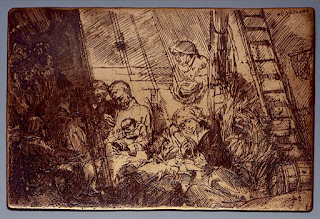Introduction
Lithography is a type of printing that uses oil-based ink to transfer an image onto a plate. The plate is then pressed against paper, which absorbs the ink and transfers it to the page. Etching is a similar process in which an artist makes marks on metal plates, exposing the metal and allowing acid to eat away at the surface, creating new textures and marks in the metal.
In order to make an etching, artists need a metal plate that has an acid-resistant coating, a drawing tool with a sharp end and an acid bath.
In order to make an etching, artists need a metal plate that has an acid-resistant coating, a drawing tool with a sharp end and an acid bath.
The artist uses the plate to draw on it with the sharp end of their instrument. They then dip the plate into an acid bath for just long enough for their drawing to be etched into the metal. After this process is done, they rinse away some of the ink so all that remains on top is their artwork in relief.
Etchings are made on metal plates that have been treated with acid, which makes the metal susceptible to damage and allows for the creation of marks.
 |
| Rembrandt's Etching from a Copper Plate |
In etching, an image is created on a metal plate that has been treated with acid to make the surface susceptible to damage and marks. The plate is then inked and printed. This process is opposite to lithography, which involves creating an image on a smooth surface (like paper) instead of on something rough like metal.
Etching uses acid to create the images instead of ink like lithography does. Etchings are made on metal plates that have been treated with acid, which makes the metal susceptible to damage and allows for the creation of marks.
Artists use a needle or other pointed tool to scratch or draw through the coating on the metal plate.
The artist uses a needle or other pointed tool to scratch or draw through the coating on the metal plate. The ink is then transferred from the metal plate onto paper, leaving behind an image that has been carved into—or etched in—the surface of the metal.
Needle: A needle is sharp and pointed, making it well-suited for scratching through coatings on a metal plate to reveal an underlying layer.
Draw: Draw is often used as a verb meaning "to create by making marks with a pencil." In this context, we mean drawing with any sort of pointed tool that can be used to create marks (lines) in something else—in this case, our blank piece of paper!
The exposed metal is then immersed in an acid bath.
The exposed metal is then immersed in an acid bath. The acid bath is a chemical solution that dissolves the exposed metal. It can be composed of ferric chloride, hydrochloric acid or nitric acid, and heated to a temperature of around 100 degrees Celsius.
The artist can also use this technique to create textures that can be filled with ink, such as clouds or grass.
The artist can also use this technique to create textures that can be filled with ink, such as clouds or grass. For example, a sponge is commonly used for the sky in a landscape painting. By applying paint onto the surface of the paper or canvas with a wet sponge and then applying more water on top of this layer, an image resembling clouds can be created.
In lithography, images are created directly onto stone or aluminum plates.
In lithography, images are created directly onto stone or aluminum plates. The plate is then placed in a printing press and ink is applied to the raised areas of the image. When paper comes into contact with the plate, it picks up a copy of that image.
In etching, an artist creates an original drawing on a metal plate using acid. The artist then adds pressure to transfer this drawing onto another piece of metal such as zinc.
Artists draw directly onto these surfaces with arbitrary marks and textures and then use water based ink to transfer those images onto paper.
Artists draw directly onto these surfaces with arbitrary marks and textures, then use water based ink to transfer those images onto paper. The paper is placed on top of the stone or aluminum plate so that it can absorb the ink from the surface via pressure. This form of lithography is known as platemaking.
The paper is placed on top of the stone or aluminum plate so that it can absorb the ink from the surface via pressure.
The water-based ink is then pressed onto the paper from the surface of the stone or aluminum plate using pressure. As a result, you are able to make prints that look just like lithographs but without having to use any chemicals.
Lithography uses water and ink to transfer a printed image whereas etching uses engraved image and pressure to transfer an image
Lithography is a printing technique where the image is transferred from a stone or metal plate to paper. Etching, on the other hand, utilizes depressions in a metal plate where ink is trapped. It then transfers to a substrate when put under pressure.
Conclusion
Both lithography and etching are methods of printing that have been in use since the early 19th century. As printing technology has improved over time, both processes have remained popular among artists who want to make artistic prints from their drawings or photographs.

Comments
Post a Comment